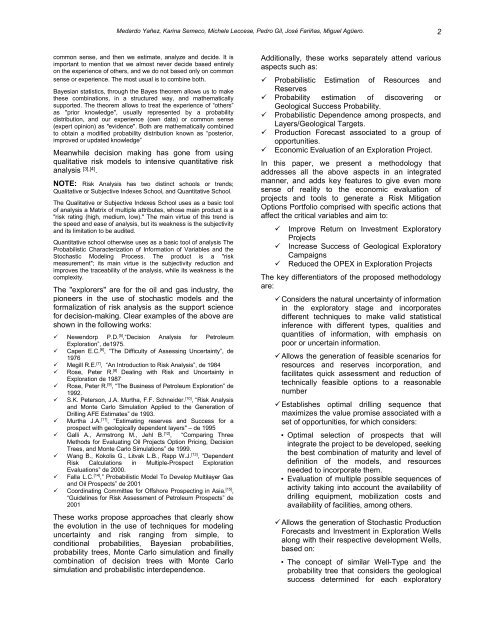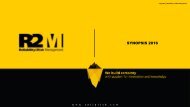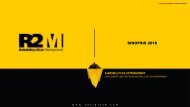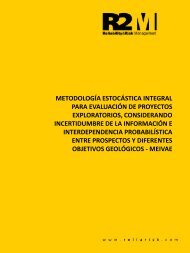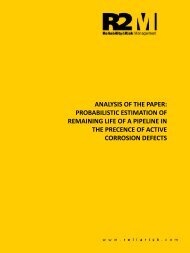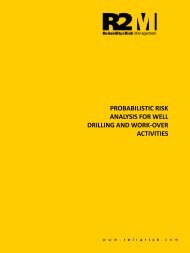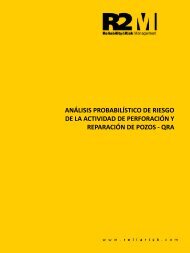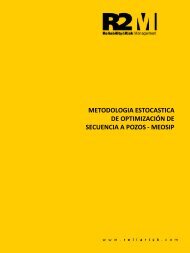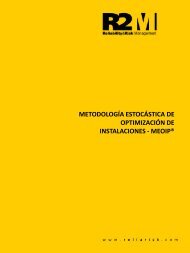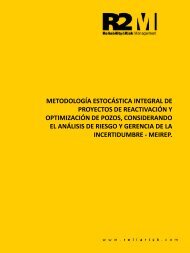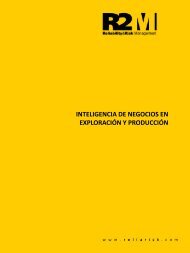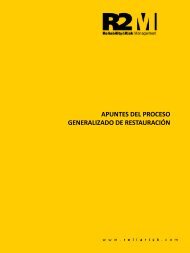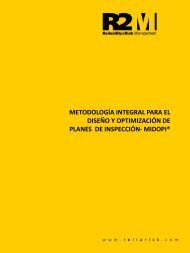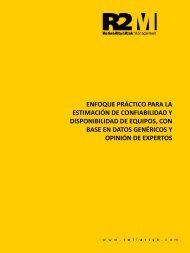Stochastic Evaluation of Exploration Assets - MEIVAE
You also want an ePaper? Increase the reach of your titles
YUMPU automatically turns print PDFs into web optimized ePapers that Google loves.
Medardo Yañez, Karina Semeco, Michele Leccese, Pedro Gil, José Fariñas, Miguel Agüero. 2<br />
common sense, and then we estimate, analyze and decide. It is<br />
important to mention that we almost never decide based entirely<br />
on the experience <strong>of</strong> others, and we do not based only on common<br />
sense or experience. The most usual is to combine both.<br />
Bayesian statistics, through the Bayes theorem allows us to make<br />
these combinations, in a structured way, and mathematically<br />
supported. The theorem allows to treat the experience <strong>of</strong> “others”<br />
as "prior knowledge", usually represented by a probability<br />
distribution, and our experience (own data) or common sense<br />
(expert opinion) as "evidence". Both are mathematically combined<br />
to obtain a modified probability distribution known as “posterior,<br />
improved or updated knowledge”<br />
Meanwhile decision making has gone from using<br />
qualitative risk models to intensive quantitative risk<br />
analysis [3],[4] .<br />
NOTE: Risk Analysis has two distinct schools or trends;<br />
Qualitative or Subjective Indexes School, and Quantitative School.<br />
The Qualitative or Subjective Indexes School uses as a basic tool<br />
<strong>of</strong> analysis a Matrix <strong>of</strong> multiple attributes, whose main product is a<br />
"risk rating (high, medium, low)." The main virtue <strong>of</strong> this trend is<br />
the speed and ease <strong>of</strong> analysis, but its weakness is the subjectivity<br />
and its limitation to be audited.<br />
Quantitative school otherwise uses as a basic tool <strong>of</strong> analysis The<br />
Probabilistic Characterization <strong>of</strong> Information <strong>of</strong> Variables and the<br />
<strong>Stochastic</strong> Modeling Process. The product is a "risk<br />
measurement"; its main virtue is the subjectivity reduction and<br />
improves the traceability <strong>of</strong> the analysis, while its weakness is the<br />
complexity.<br />
The "explorers" are for the oil and gas industry, the<br />
pioneers in the use <strong>of</strong> stochastic models and the<br />
formalization <strong>of</strong> risk analysis as the support science<br />
for decision-making. Clear examples <strong>of</strong> the above are<br />
shown in the following works:<br />
Newendorp P.D. [5] ,“Decision Analysis for Petroleum<br />
<strong>Exploration</strong>”, de1975.<br />
Capen E.C. [6] , “The Difficulty <strong>of</strong> Assessing Uncertainty”, de<br />
1976<br />
Megill R.E. [7] , “An Introduction to Risk Analysis”, de 1984<br />
Rose, Peter R. [8] Dealing with Risk and Uncertainty in<br />
<strong>Exploration</strong> de 1987<br />
Rose, Peter R. [9] , “The Business <strong>of</strong> Petroleum <strong>Exploration</strong>” de<br />
1992.<br />
S.K. Peterson, J.A. Murtha, F.F. Schneider. [10] , “Risk Analysis<br />
and Monte Carlo Simulation Applied to the Generation <strong>of</strong><br />
Drilling AFE Estimates” de 1993.<br />
<br />
Murtha J.A. [11] , “Estimating reserves and Success for a<br />
prospect with geologically dependent layers" – de 1995<br />
Galli A., Armstrong M., Jehl B. [12] , “Comparing Three<br />
Methods for Evaluating Oil Projects Option Pricing, Decision<br />
Trees, and Monte Carlo Simulations” de 1999.<br />
<br />
<br />
Wang B., Kokolis G., Litvak L.B., Rapp W.J. [13] , “Dependent<br />
Risk Calculations in Multiple-Prospect <strong>Exploration</strong><br />
<strong>Evaluation</strong>s” de 2000.<br />
Falla L.C. [14] ,” Probabilistic Model To Develop Multilayer Gas<br />
and Oil Prospects” de 2001<br />
Coordinating Committee for Offshore Prospecting in Asia. [15] ,<br />
“Guidelines for Risk Assessment <strong>of</strong> Petroleum Prospects” de<br />
2001<br />
These works propose approaches that clearly show<br />
the evolution in the use <strong>of</strong> techniques for modeling<br />
uncertainty and risk ranging from simple, to<br />
conditional probabilities, Bayesian probabilities,<br />
probability trees, Monte Carlo simulation and finally<br />
combination <strong>of</strong> decision trees with Monte Carlo<br />
simulation and probabilistic interdependence.<br />
Additionally, these works separately attend various<br />
aspects such as:<br />
Probabilistic Estimation <strong>of</strong> Resources and<br />
Reserves<br />
Probability estimation <strong>of</strong> discovering or<br />
Geological Success Probability.<br />
Probabilistic Dependence among prospects, and<br />
Layers/Geological Targets.<br />
Production Forecast associated to a group <strong>of</strong><br />
opportunities.<br />
Economic <strong>Evaluation</strong> <strong>of</strong> an <strong>Exploration</strong> Project.<br />
In this paper, we present a methodology that<br />
addresses all the above aspects in an integrated<br />
manner, and adds key features to give even more<br />
sense <strong>of</strong> reality to the economic evaluation <strong>of</strong><br />
projects and tools to generate a Risk Mitigation<br />
Options Portfolio comprised with specific actions that<br />
affect the critical variables and aim to:<br />
<br />
<br />
<br />
Improve Return on Investment Exploratory<br />
Projects<br />
Increase Success <strong>of</strong> Geological Exploratory<br />
Campaigns<br />
Reduced the OPEX in <strong>Exploration</strong> Projects<br />
The key differentiators <strong>of</strong> the proposed methodology<br />
are:<br />
Considers the natural uncertainty <strong>of</strong> information<br />
in the exploratory stage and incorporates<br />
different techniques to make valid statistical<br />
inference with different types, qualities and<br />
quantities <strong>of</strong> information, with emphasis on<br />
poor or uncertain information.<br />
Allows the generation <strong>of</strong> feasible scenarios for<br />
resources and reserves incorporation, and<br />
facilitates quick assessment and reduction <strong>of</strong><br />
technically feasible options to a reasonable<br />
number<br />
Establishes optimal drilling sequence that<br />
maximizes the value promise associated with a<br />
set <strong>of</strong> opportunities, for which considers:<br />
• Optimal selection <strong>of</strong> prospects that will<br />
integrate the project to be developed, seeking<br />
the best combination <strong>of</strong> maturity and level <strong>of</strong><br />
definition <strong>of</strong> the models, and resources<br />
needed to incorporate them.<br />
• <strong>Evaluation</strong> <strong>of</strong> multiple possible sequences <strong>of</strong><br />
activity taking into account the availability <strong>of</strong><br />
drilling equipment, mobilization costs and<br />
availability <strong>of</strong> facilities, among others.<br />
Allows the generation <strong>of</strong> <strong>Stochastic</strong> Production<br />
Forecasts and Investment in <strong>Exploration</strong> Wells<br />
along with their respective development Wells,<br />
based on:<br />
• The concept <strong>of</strong> similar Well-Type and the<br />
probability tree that considers the geological<br />
success determined for each exploratory


